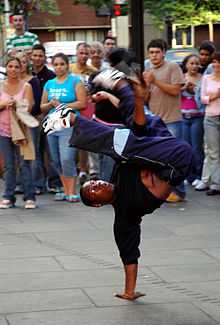Power move
Power moves are moves loosely defined as relying on speed, momentum, and acrobatic elements for performance. They are prominent in B-boying, often the centerpieces of routines featuring the other elements (toprock, downrock, and freezes) that make up breaking. Also, power moves is near to gymnastics more than dancing. B-boys who focus heavily on power moves and execute them as a main part of their routines are often called "power heads". [1] It was discovered by DJ Kool Herc. The definition of B-boying is basically break dancing and gets into the music.[1]

Origin
The float and Headmills aka Power windmills and incorporated flares suicides into breaking then B-boys cut the phrase down in the 90's from powerful moves to power moves with poetic rhythm linguistics Syllable Syllable to make it sound more flashy. Nowadays B-boys are executing more acrobatics now which are the new power moves of the day it has evolved with the new generation to a higher level.
Types
Spins
- Back spin: One of the first and most famous spinning power moves, the dancer is balled up and spinning on his or her back. In some variations, the dancer may choose to hop while spinning.
- Shoulder spin
- Air chair spin
- The headspin is an athletic move in which a person spins on their head from a headstand position. These may be done continuously through hand-tapping and proper balance.
- Hand spin
Handstand Moves
- The 1990 is a breakdance move which resembles a rapidly spinning one-handed handstand.
- 2000s are similar to 1990s, but with both hands.
Floats
Floats were one of the first power moves in the 80's. The body is usually in a fixed position while the arms move.
- Crickets and variants: Hydro, Jackhammer, Lotus Jackhammer, Super Jackhammer, Darkhammer, Hopping Turtles/Scratching Turtles, etc.
- UFO, Boomerangs, Inside Boomerangs, Gorillas, Gremlin Spins/Buddha spins
Swipes
Swipes are one of the most recognizable power moves. The b-boy or b-girl leans back, whips his or her arms to one side to touch the ground, and his or her legs follow closely behind, twisting 360 degrees to land on the ground once again.
- A variant is the master swipe, also known as a superman swipe or one-footed swipe
Shadow Swipes is a variation of the swipe that incorporates the chair freeze to start the swipe. Created by Bboy Kid Shade of Hong Kong, it is one of his signature moves.
Windmills
The headmill is a windmill variant performed without the use of hands for stability, rotating with the head and shoulders as the pivot point. As headmills free the hands, there are many further variations defined by the positioning of the hands.
Major windmill variants:
- Mummies
- Nutcrackers
- Eggbeaters
- HandCuffs
- Bellymills
- Confusions
- Barrels
- Forearms
- Airplane/Highrisers/Highrises
Flares
Flares are a widely recognized power move borrowed from gymnastics. Major variants:
- King Flares/Hopping Flare
- Twin-
- Crossed-legged Flare
- Chair Flare
- Double Chair Flare
- Sandwich Flare
- Lotus Flare
- Thread Flare
- One-legged Flare
- Virgin/Double Leg Circles - flares done with closed, straight legs
Air moves
Air moves are often referred to as power moves but are not; they require momentum, balance, and upper body control to execute. These athletic moves are characterized by the dancer's feet not touching the floor for an extended period of time while he or she maintains a sustained spin in the air.
- Kid Freeze is credited for creating the first airmoves and continuous Headspins.
- Icey ice is credited for Halos aka air tracks footwork air moves are examples of air moves . Air moves rely heavily on momentum, often achieved by swinging the legs and twisting the torso in a circular motion. The arms usually bear the body's weight while the abdominal and lower back muscles must whip the legs around as needed to spin the body. The lighter you are the more easy it is to execute these moves.
References
- ↑ 1.0 1.1 Okumura, Kozo. "B-boying". Dancers Delight. Retrieved 10 December 2013.
Russian Power Move Community [1]
- ↑ Okumura, Kozo. "B-Boying". Dancers Delight.
See also
| ||||||||||||||||||||||